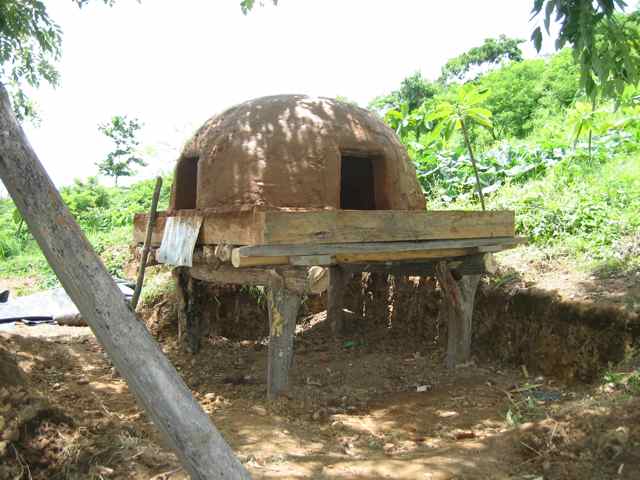Here are only a few pictures of our earthen oven being made by Felix and Winston. If anyone is interested in learning more about the Nica method of earthen oven building, my own personal web page will have more photos w/ detailed explanation soon. www.casalachabola.com. Until then, here's a small glimpse of how it's done, local-style.
oven base: small tree trunks, covered with 6 mm plastic then topped with tampped earth and sand encased by four wood planks. General oven structure: adobe bricks w/ clay-horse manure mix as mortar. Rebar as mini cross beam for doors. Oven floor: adobe floor tiles
very top of oven closed-in by broken peices of adobe roof tile and clay-horse manure mix.
finished product: bread entrance door on right, ash exit door on left. doors, and decorative elements to come...
- Nica Linda's Blog
- Log in or register to post comments



Linda. That looks like it ought to be a very useful oven when it is completed.
A couple of questions, when you can spare the time to answer:
1. The clay I understand, but not the horse manure. Does the manure contribute fiber, therefore additional strength, like straw does in other adobe mixes?
2. Will the horse manure odor dissipate after several firings?
3. Why a wooden base, instead of stone or adobe? I would have thought that wood would be more susceptible to decay or termite attack, particularly in your climate. Or is there an expectation that the next hurricane or earthquake will knock everything down before the wood goes bad?
Congrats on a great start.
Paul
There was an episode of Dirty Jobs where they added horse manure to the sand used when they cast bells. It was sifted to remove fibers and what remained had properties that helped keep the shape of the cooling bell. Unfortunately, I don't remember exactly how it helped. Perhaps someone else remembers?
I'm also curious about the need for horse manure. Looks like a great start and I'm sure WFO are rewarding. Dave
That is AMAZING!!!!! I too have my questions about horse manure vs whatever else is handy. We are planning to raise goats and make chese, soap and breads in the next 2 years as well as firing some home made pottery. At the risk of sounding really stupid....is it at all possible to use the same oven for the same things....of course not at the same time as I am sure the breads would be charcoal at the pottery firing temps!! But could we use it for them both?? Any suggestions on where to find the info to build them....especially if we have to build 2 different ones...which would be find with me!! GOD I LOVE THIS SITE!!!!
THANK YOU!!
My what beautiful scenery your oven sits in...I too am curious as to your materials and the use of two doors instead of an area outside the front door shelf with an opening to sweep the ash down..my first thought as to seeing your foundation was...are you planning on moving your oven? I can appreciate all the hard work you are putting into your oven.
Sylvia
I realize this is an old post, but I wanted to read the details on the website posted, but it is no longer valid. I would like to ask about manure specifically. Can I use a higher ratio? Getting clay on my island will prove impossible.